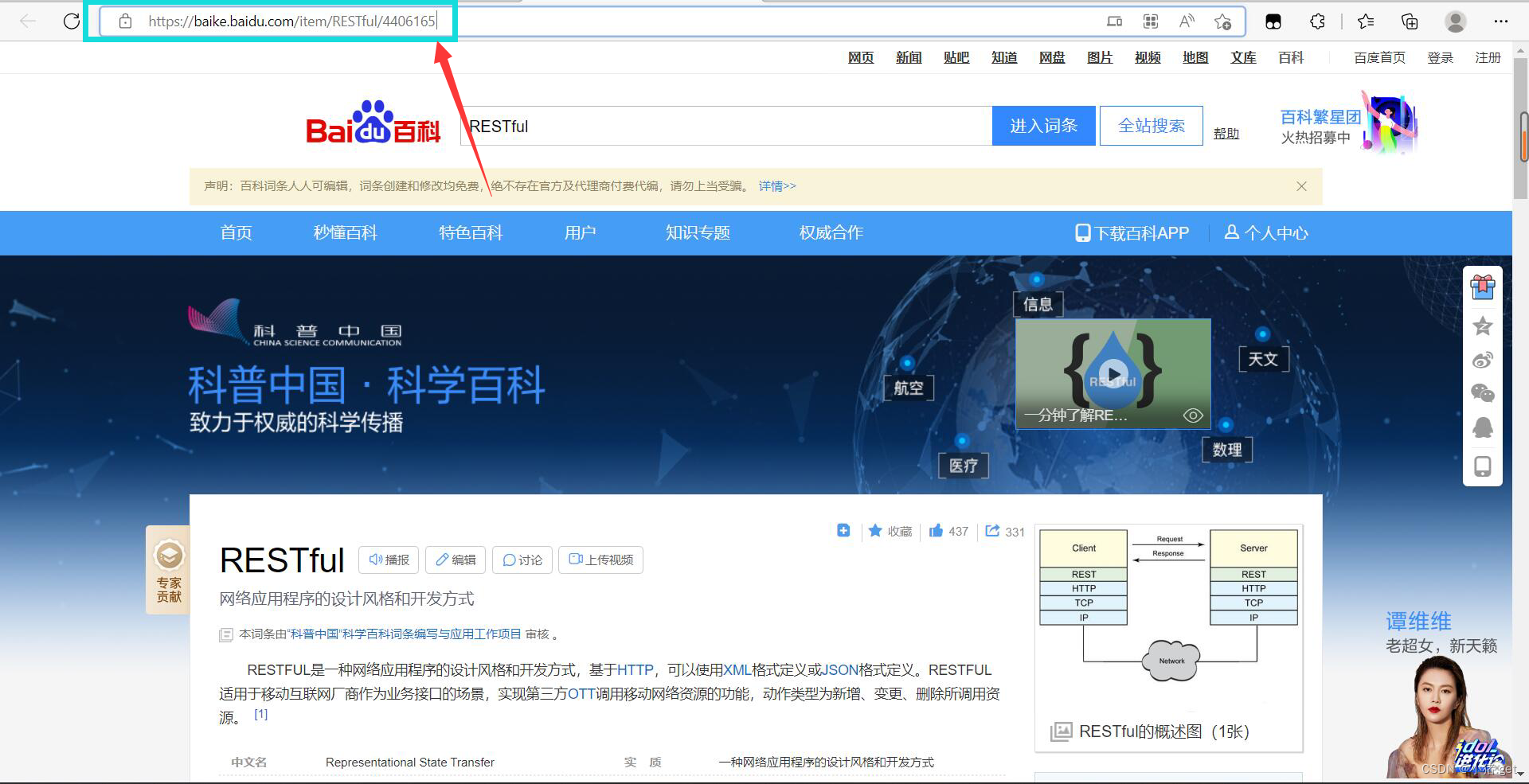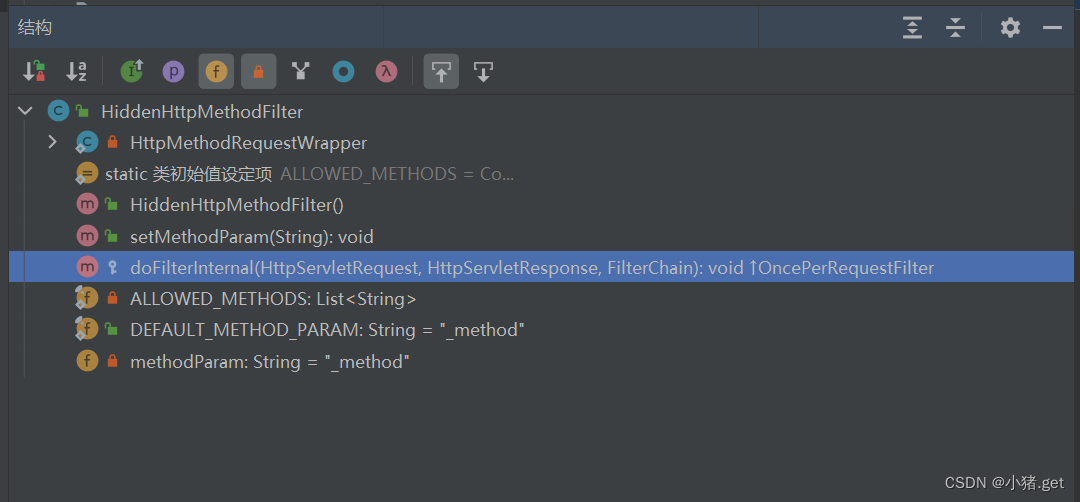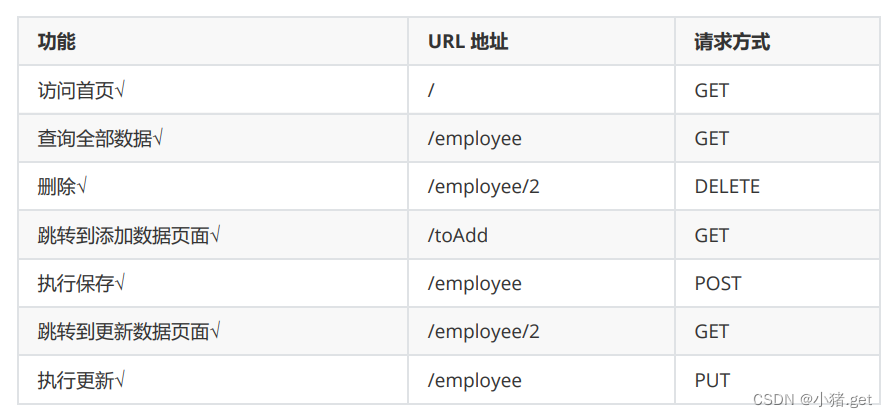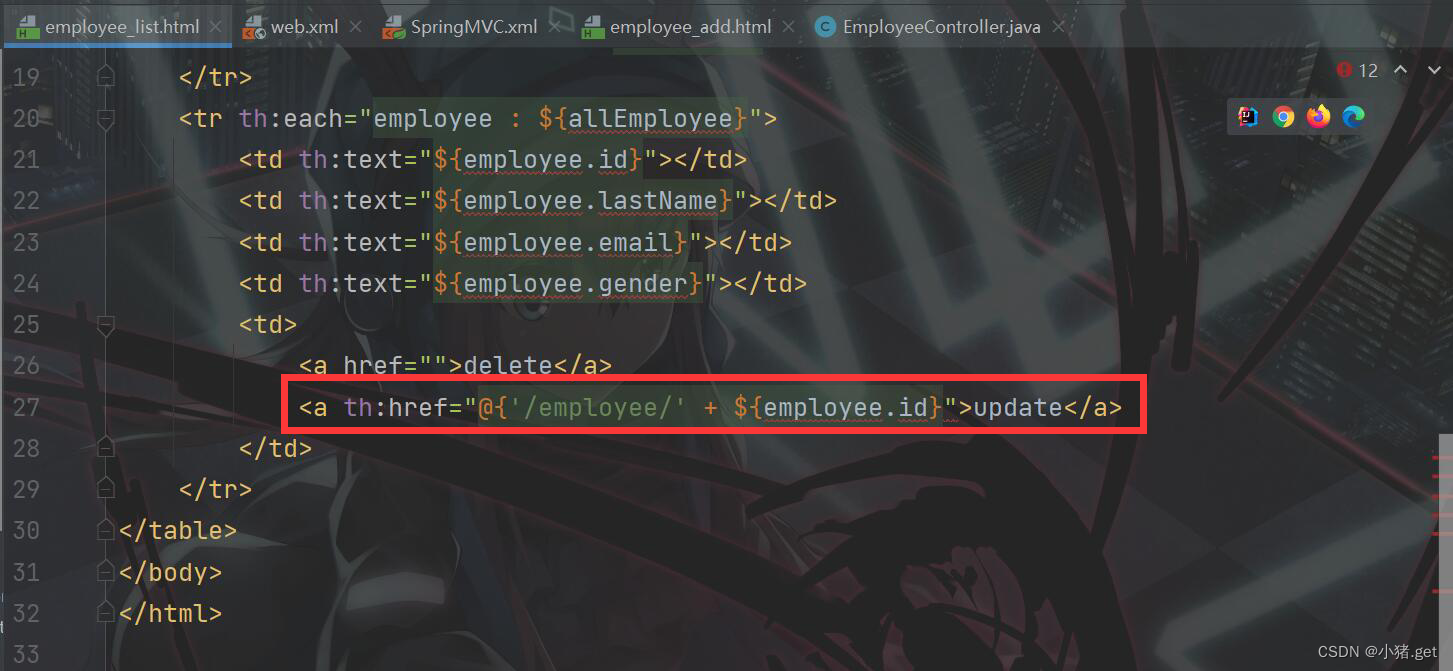目录
🦆使用HiddenHttpMethodFilter处理put和delete请求
⭐HiddenHttpMethodFilter 处理put和delete请求的条件:

一、简介
REST:Representational State Transfer,表现层资源状态转移。
RESTFUL:是一种网络应用程序的设计风格和开发方式,基于HTTP,可以使用XML格式定义或JSON格式定义。RESTFUL适用于移动互联网厂商作为业务接口的场景,实现第三方OTT调用移动网络资源的功能,动作类型为新增、变更、删除所调用资源
1.资源
资源是一种看待服务器的方式,即,将服务器看作是由很多离散的资源组成。
每个资源是服务器上一个可命名的抽象概念。
因为资源是一个抽象的概念,所以它不仅仅能代表服务器文件系统中的一个文件、 数据库中的一张表等等具体的东西,可以将资源设计的要多抽象有多抽象,只要想象力允许而且客户端 应用开发者能够理解。
与面向对象设计类似,资源是以名词为核心来组织的,首先关注的是名词。
一个资源可以由一个或多个URI来标识。URI既是资源的名称,也是资源在Web上的地址。对某个资源感兴趣的客户端应用,可以通过资源的URI与其进行交互。
2.资源的表述
资源的表述是一段对于资源在某个特定时刻的状态的描述。
可以在客户端-服务器端之间转移(交 换)。资源的表述可以有多种格式,例如HTML/XML/JSON/纯文本/图片/视频/音频等等。资源的表述格式可以通过协商机制来确定。
请求 —— 响应方向的表述通常使用不同的格式。
3.状态转移
在客户端和服务器端之间转移(transfer)代表资源状态的表述。
通过转移和操作资源的表述,来间接实现操作资源的目的。
4.特点
- 每一个URI代表1种资源;
- 客户端使用GET、POST、PUT、DELETE4个表示操作方式的动词对服务端资源进行操作:GET用来获取资源,POST用来新建资源(也可以用于更新资源),PUT用来更新资源,DELETE用来删除资源;
- 通过操作资源的表现形式来操作资源;
- 资源的表现形式是XML或者HTML;
- 客户端与服务端之间的交互在请求之间是无状态的,从客户端到服务端的每个请求都必须包含理解请求所必需的信息。
二、实现
HTTP 协议里面,四个表示操作方式的动词:GET(获取资源)、POST(新建资源)、PUT(更新资源)、DELETE(删除资源)。
REST 风格提倡 URL 地址使用统一的风格设计,从前到后各个单词使用斜杠分开,不使用问号键值对方式携带请求参数,而是将要发送给服务器的数据作为 URL 地址的一部分,以保证整体风格的一致性。

三、RESTful基础案例
1.准备工作
①配置web.xml
<?xml version="1.0" encoding="UTF-8"?>
<web-app xmlns="http://xmlns.jcp.org/xml/ns/javaee"
xmlns:xsi="http://www.w3.org/2001/XMLSchema-instance"
xsi:schemaLocation="http://xmlns.jcp.org/xml/ns/javaee http://xmlns.jcp.org/xml/ns/javaee/web-app_4_0.xsd"
version="4.0">
<!-- 设置spring的编码过滤器 -->
<filter>
<filter-name>CharacterEncodingFilter</filter-name>
<filter-class>org.springframework.web.filter.CharacterEncodingFilter</filter-class>
<init-param>
<param-name>encoding</param-name>
<param-value>UTF-8</param-value>
</init-param>
<init-param>
<param-name>forceEncoding</param-name>
<param-value>true</param-value>
</init-param>
</filter>
<filter-mapping>
<filter-name>CharacterEncodingFilter</filter-name>
<url-pattern>/*</url-pattern>
</filter-mapping>
<!-- 设置SpringMVC的前端控制器 -->
<servlet>
<servlet-name>SpringMVC</servlet-name>
<servlet-class>org.springframework.web.servlet.DispatcherServlet</servlet-class>
<init-param>
<param-name>contextConfigLocation</param-name>
<param-value>classpath:SpringMVC.xml</param-value>
</init-param>
<load-on-startup>1</load-on-startup>
</servlet>
<servlet-mapping>
<servlet-name>SpringMVC</servlet-name>
<url-pattern>/</url-pattern>
</servlet-mapping>
</web-app>②配置SpringMVC.xml
<?xml version="1.0" encoding="UTF-8"?>
<beans xmlns="http://www.springframework.org/schema/beans"
xmlns:xsi="http://www.w3.org/2001/XMLSchema-instance"
xmlns:context="http://www.springframework.org/schema/context"
xmlns:mvc="http://www.springframework.org/schema/mvc"
xsi:schemaLocation="http://www.springframework.org/schema/beans
http://www.springframework.org/schema/beans/spring-beans-4.2.xsd
http://www.springframework.org/schema/mvc
http://www.springframework.org/schema/mvc/spring-mvc-4.2.xsd
http://www.springframework.org/schema/context
http://www.springframework.org/schema/context/spring-context-4.2.xsd">
<!-- 扫面控制层组件 -->
<context:component-scan base-package="com.atguigu.controller"></context:component-scan>
<!-- 配置Thymeleaf视图解析器 -->
<bean id="viewResolver"
class="org.thymeleaf.spring5.view.ThymeleafViewResolver">
<property name="order" value="1"/><!--order:优先级-->
<property name="characterEncoding" value="UTF-8"/><!--characterEncoding:编码-->
<property name="templateEngine"><!--templateEngine:模板引擎-->
<bean class="org.thymeleaf.spring5.SpringTemplateEngine">
<property name="templateResolver"><!--templateResolver:模板解析器-->
<bean class="org.thymeleaf.spring5.templateresolver.SpringResourceTemplateResolver">
<!-- 物理视图:/WEB-INF/templates/index.xml -->
<!-- 物理视图 = 视图前缀 + 逻辑视图 + 视图后缀 -->
<!-- 逻辑视图:index(可以通过逻辑视图访问到物理视图) -->
<!-- 视图前缀 -->
<property name="prefix" value="/WEB-INF/templates/"/>
<!-- 视图后缀 -->
<property name="suffix" value=".html"/>
<property name="templateMode" value="HTML5"/><!-- 模板模型:HTML5 -->
<property name="characterEncoding" value="UTF-8" /><!-- 渲染视图默认的编码:UTF-8 -->
</bean>
</property>
</bean>
</property>
</bean>
<!-- 开启mvc的注解驱动 -->
<mvc:annotation-driven/>
<!-- 配置视图控制器 -->
<mvc:view-controller path="/" view-name="index"></mvc:view-controller>
</beans>③功能
/**
* 查询所有的用户信息 ——> /user ——> get
* 根据id查询用户信息 ——> /user/1 ——> get
* 添加用户信息 ——> /user ——> post
* 修改用户信息 ——> /user ——> put
* 删除用户信息 ——> /user/1 ——> delete
*/
@Controller
public class TestRestController {
}④实现
<!DOCTYPE html>
<html lang="en" xmlns:th="http://www.thymeleaf.org">
<head>
<meta charset="UTF-8">
<title>首页</title>
</head>
<body>
<h1>index.html</h1>
<a th:href="@{/user}">查询所有的用户信息</a><br>
<a th:href="@{/user/1}">查询id为1的用户信息</a><br>
<form th:action="@{/user}" method="post">
<input type="submit" value="添加用户信息">
</form>
<form th:action="@{/user}" method="post">
<input type="hidden" name="_method" value="put">
<input type="submit" value="修改用户信息">
</form>
<form th:action="@{/user/5}" method="post">
<input type="hidden" name="_method" value="delete">
<input type="submit" value="删除用户信息">
</form>
</body>
</html>package com.atguigu.controller;
import org.springframework.stereotype.Controller;
import org.springframework.web.bind.annotation.*;
/**
* 查询所有的用户信息 ——> /user ——> get
* 根据id查询用户信息 ——> /user/1 ——> get
* 添加用户信息 ——> /user ——> post
* 修改用户信息 ——> /user ——> put
* 删除用户信息 ——> /user/1 ——> delete
*/
@Controller
public class TestRestController {
// @RequestMapping(value = "/user",method = RequestMethod.GET)
@GetMapping("/user")
public String getAllUser(){
System.out.println("查询所有的用户信息 ——> /user ——> get");
return "success";
}
// @RequestMapping(value = "/user/{id}",method = RequestMethod.GET)
@GetMapping("/user/{id}")
//获取请求参数
public String getUserById(@PathVariable("id") Integer id){
System.out.println("根据id查询用户信息 ——> /user/" + id +" ——> get");
return "success";
}
// @RequestMapping(value = "/user",method = RequestMethod.POST)
@PostMapping("/user")
public String insertUser(){
System.out.println("添加用户信息 ——> /user ——> post");
return "success";
}
// @RequestMapping(value = "/user",method = RequestMethod.PUT)
@PutMapping("/user")
public String updateUser(){
System.out.println("修改用户信息 ——> /user ——> put");
return "success";
}
// @RequestMapping(value = "/user/{id}",method = RequestMethod.DELETE)
@DeleteMapping("/user/{id}")
public String deleteUser(@PathVariable("id") Integer id){
System.out.println("删除用户信息 ——> /user/" + id +"——> delete");
return "success";
}
}
🦆使用HiddenHttpMethodFilter处理put和delete请求
由于浏览器只支持发送get和post方式的请求,那么该如何发送put和delete请求呢?
SpringMVC 提供了 HiddenHttpMethodFilter 帮助我们将 POST 请求转换为 DELETE 或 PUT 请求
⭐HiddenHttpMethodFilter 处理put和delete请求的条件:
- 当前请求的请求方式必须为post
- 当前请求必须传输请求参数_method
满足以上条件,HiddenHttpMethodFilter 过滤器就会将当前请求的请求方式转换为请求参数 _method的值,因此请求参数_method的值才是最终的请求方式
在web.xml中注册HiddenHttpMethodFilter
<!-- 设置处理请求方式的过滤器 -->
<filter>
<filter-name>HiddenHttpMethodFilter</filter-name>
<filter-class>org.springframework.web.filter.HiddenHttpMethodFilter</filter-class>
</filter>
<filter-mapping>
<filter-name>HiddenHttpMethodFilter</filter-name>
<url-pattern>/*</url-pattern>
</filter-mapping>HiddenHttpMethodFilter的源码
public class HiddenHttpMethodFilter extends OncePerRequestFilter {
private static final List<String> ALLOWED_METHODS;
public static final String DEFAULT_METHOD_PARAM = "_method";
private String methodParam = "_method";
public HiddenHttpMethodFilter() {
}
public void setMethodParam(String methodParam) {
Assert.hasText(methodParam, "'methodParam' must not be empty");
this.methodParam = methodParam;
}
protected void doFilterInternal(HttpServletRequest request, HttpServletResponse response, FilterChain filterChain) throws ServletException, IOException {
HttpServletRequest requestToUse = request;
if ("POST".equals(request.getMethod()) && request.getAttribute("javax.servlet.error.exception") == null) {
String paramValue = request.getParameter(this.methodParam);
if (StringUtils.hasLength(paramValue)) {
String method = paramValue.toUpperCase(Locale.ENGLISH);
if (ALLOWED_METHODS.contains(method)) {
requestToUse = new HiddenHttpMethodFilter.HttpMethodRequestWrapper(request, method);
}
}
}
filterChain.doFilter((ServletRequest)requestToUse, response);
}
static {
ALLOWED_METHODS = Collections.unmodifiableList(Arrays.asList(HttpMethod.PUT.name(), HttpMethod.DELETE.name(), HttpMethod.PATCH.name()));
}
private static class HttpMethodRequestWrapper extends HttpServletRequestWrapper {
private final String method;
public HttpMethodRequestWrapper(HttpServletRequest request, String method) {
super(request);
this.method = method;
}
public String getMethod() {
return this.method;
}
}
}

四、RESTful具体案例
1.创建实体类、dao模拟数据、创建控制层
package com.atguigu.pojo;
public class Employee {
private Integer id;
private String lastName;
private String email;
//1 male, 0 female
private Integer gender;
public Integer getId() {
return id;
}
public void setId(Integer id) {
this.id = id;
}
public String getLastName() {
return lastName;
}
public void setLastName(String lastName) {
this.lastName = lastName;
}
public String getEmail() {
return email;
}
public void setEmail(String email) {
this.email = email;
}
public Integer getGender() {
return gender;
}
public void setGender(Integer gender) {
this.gender = gender;
}
public Employee(Integer id, String lastName, String email, Integer
gender) {
super();
this.id = id;
this.lastName = lastName;
this.email = email;
this.gender = gender;
}
public Employee() {
}
}package com.atguigu.dao;
import com.atguigu.pojo.Employee;
import org.springframework.stereotype.Repository;
import java.util.Collection;
import java.util.HashMap;
import java.util.Map;
@Repository
public class EmployeeDao {
private static Map<Integer, Employee> employees = null;
static{
employees = new HashMap<Integer, Employee>();
employees.put(1001, new Employee(1001, "E-AA", "aa@163.com", 1));
employees.put(1002, new Employee(1002, "E-BB", "bb@163.com", 1));
employees.put(1003, new Employee(1003, "E-CC", "cc@163.com", 0));
employees.put(1004, new Employee(1004, "E-DD", "dd@163.com", 0));
employees.put(1005, new Employee(1005, "E-EE", "ee@163.com", 1));
}
private static Integer initId = 1006;
public void save(Employee employee){
if(employee.getId() == null){
employee.setId(initId++);
}
employees.put(employee.getId(), employee);
}
public Collection<Employee> getAll(){
return employees.values();
}
public Employee get(Integer id){
return employees.get(id);
}
public void delete(Integer id){
employees.remove(id);
}
}
import org.springframework.stereotype.Controller;
/**
* 查询所有的员工信息 ——> /employee ——> get
* 跳转到添加页面 ——> /to/add ——> get
* 新增员工信息 ——> /employee ——> post
* 跳转到修改页面 ——> /employee/1 ——> get
* 修改员工信息 ——> /employee ——> put
* 删除员工信息 ——> /employee/1 ——> delete
* *
*/
@Controller
public class EmployeeController {
}
2. 功能清单

3.处理静态资源
html:
<!DOCTYPE html>
<html lang="en" xmlns:th="http://www.thymeleaf.org">
<head>
<meta charset="UTF-8">
<title>employee list</title>
<link rel="stylesheet" th:href="@{/static/css/index_work.css}">
</head>
<body>
<table>
<tr>
<th colspan="5">employee list</th>
</tr>
<tr>
<th>id</th>
<th>lastName</th>
<th>email</th>
<th>gender</th>
<th>options</th>
</tr>
<tr th:each="employee : ${allEmployee}">
<td th:text="${employee.id}"></td>
<td th:text="${employee.lastName}"></td>
<td th:text="${employee.email}"></td>
<td th:text="${employee.gender}"></td>
<td>
<a href="">delete</a>
<a href="">update</a>
</td>
</tr>
</table>
</body>
</html>控制层:
@Controller
public class EmployeeController {
@Autowired
private EmployeeDao employeeDao;
@RequestMapping(value = "/employee",method = RequestMethod.GET)
public String getAllEmployee(Model model){
//获取所有的员工信息
Collection<Employee> allEmployee = employeeDao.getAll();
//将所有的员工信息在请求域中共享
model.addAttribute("allEmployee",allEmployee);
//跳转到列表页面
return "employee_list";
}
}
SpringMVC.xml
<!-- 配置默认的servlet处理静态资源:
当前工程的web.xml配置的前端控制器DispatcherServlet的url-pattern是 /
tomcat的web.xml配置的DispatcherServlet的url-pattern也是 /
此时,浏览器发送的请求会优先被DispatcherServlet进行处理,但是DispatcherServlet无法处理静态资源
若配置了<mvc:default-servlet-handler/>,此时浏览器发送的所有请求都会被DefaultServlet处理
若配置了<mvc:default-servlet-handler/>和<mvc:annotation-driven/>
浏览器发送的请求会先被DispatcherServlet处理
无法处理再交给DefaultServlet处理
-->
<mvc:default-servlet-handler/>
<!-- 开启mvc的注解驱动 -->
<mvc:annotation-driven/>
<!-- 配置视图控制器 -->
<mvc:view-controller path="/" view-name="index"></mvc:view-controller>添加样式后
 4.添加功能
4.添加功能
①在SpringMVC.xml中配置视图控制器
<mvc:view-controller path="/to/add" view-name="employee_add"></mvc:view-controller>②添加页面
<!DOCTYPE html>
<html lang="en" xmlns:th="http://www.thymeleaf.org">
<head>
<meta charset="UTF-8">
<title>add employee</title>
<link rel="stylesheet" th:href="@{/static/css/index_work.css}">
</head>
<body>
<form th:action="@{/employee}" method="post">
<table>
<tr>
<th colspan="2">add employee</th>
</tr>
<tr>
<td>lastName</td>
<td>
<input type="text" name="lastName">
</td>
</tr>
<tr>
<td>email</td>
<td>
<input type="text" name="email">
</td>
</tr>
<tr>
<td>gender</td>
<td>
<input type = "radio" name="gender" value="1">male
<input type = "radio" name="gender" value="0">female
</td>
</tr>
<tr>
<td colspan="2">
<input type="submit" value="add">
</td>
</tr>
</table>
</form>
</body>
</html>③控制层
@RequestMapping(value = "/employee",method = RequestMethod.POST)
public String addEmployee(Employee employee){
//保存员工信息
employeeDao.save(employee);
//重定向到列表功能:/employee
return "redirect:/employee";
}
@RequestMapping(value = "to/add",method = RequestMethod.GET)
public String addEmployee(){
return "employee_add";
}④结果


5.修改功能

①修改页面
<!DOCTYPE html>
<html lang="en" xmlns:th="http://www.thymeleaf.org">
<head>
<meta charset="UTF-8">
<title>update employee</title>
<link rel="stylesheet" th:href="@{/static/css/index_work.css}">
</head>
<body>
<form th:action="@{/employee}" method="post">
<input type="hidden" name="_method" value="put">
<input type="hidden" name="id" th:value="${employee.id}">
<table>
<tr>
<th colspan="2">update employee</th>
</tr>
<tr>
<td>lastName</td>
<td>
<input type="text" name="lastName" th:value="${employee.lastName}">
</td>
</tr>
<tr>
<td>email</td>
<td>
<input type="text" name="email" th:value="${employee.email}">
</td>
</tr>
<tr>
<td>gender</td>
<td>
<input type = "radio" name="gender" value="1" th:field="${employee.gender}">male
<input type = "radio" name="gender" value="0" th:field="${employee.gender}">female
</td>
</tr>
<tr>
<td colspan="2">
<input type="submit" value="update">
</td>
</tr>
</table>
</form>
</body>
</html>②控制层
@RequestMapping(value = "/employee",method = RequestMethod.PUT)
public String updateEmployee(Employee employee){
//修改员工信息
employeeDao.save(employee);
//重定向到列表功能:/employee
return "redirect:/employee";
}6.删除功能
<!DOCTYPE html>
<html lang="en" xmlns:th="http://www.thymeleaf.org">
<head>
<meta charset="UTF-8">
<title>employee list</title>
<link rel="stylesheet" th:href="@{/static/css/index_work.css}">
</head>
<body>
<div id="app">
<table>
<tr>
<th colspan="5">employee list</th>
</tr>
<tr>
<th>id</th>
<th>lastName</th>
<th>email</th>
<th>gender</th>
<th>options (<a th:href="@{/to/add}">add</a>) </th>
</tr>
<tr th:each="employee : ${allEmployee}">
<td th:text="${employee.id}"></td>
<td th:text="${employee.lastName}"></td>
<td th:text="${employee.email}"></td>
<td th:text="${employee.gender}"></td>
<td>
<a @click="deleteEmployee()" th:href="@{'/employee/' + ${employee.id}">delete</a>
<a th:href="@{'/employee/' + ${employee.id}">update</a>
</td>
</tr>
</table>
<form method="post">
<input type="hidden" name="_method" value="delete">
</form>
</div>
<script type="text/javascript" th:src="@{/static/js/vue.js}"></script>
<script type="text/javascript">
var vue = new Vue({
el:"#app",
methods:{
deleteEmployee(){
//获取form表单
var form = document.getElementsByTagName("form")[0];
//将超链接的href属性值赋值给form表单的action属性
//event.target表示当前触发时间的标签
form.action = event.target.href;
//表单提交
form.submit();
//组织超链接的默认行为
event.preventDefault();
}
}
});
</script>
</body>
</html>
@RequestMapping(value = "/employee/{id}",method = RequestMethod.DELETE)
public String deleteEmployee(@PathVariable("id") Integer id){
//删除员工信息
employeeDao.delete(id);
//重定向到列表功能:/employee
return "redirect:/employee";
}

























 58
58











 被折叠的 条评论
为什么被折叠?
被折叠的 条评论
为什么被折叠?










